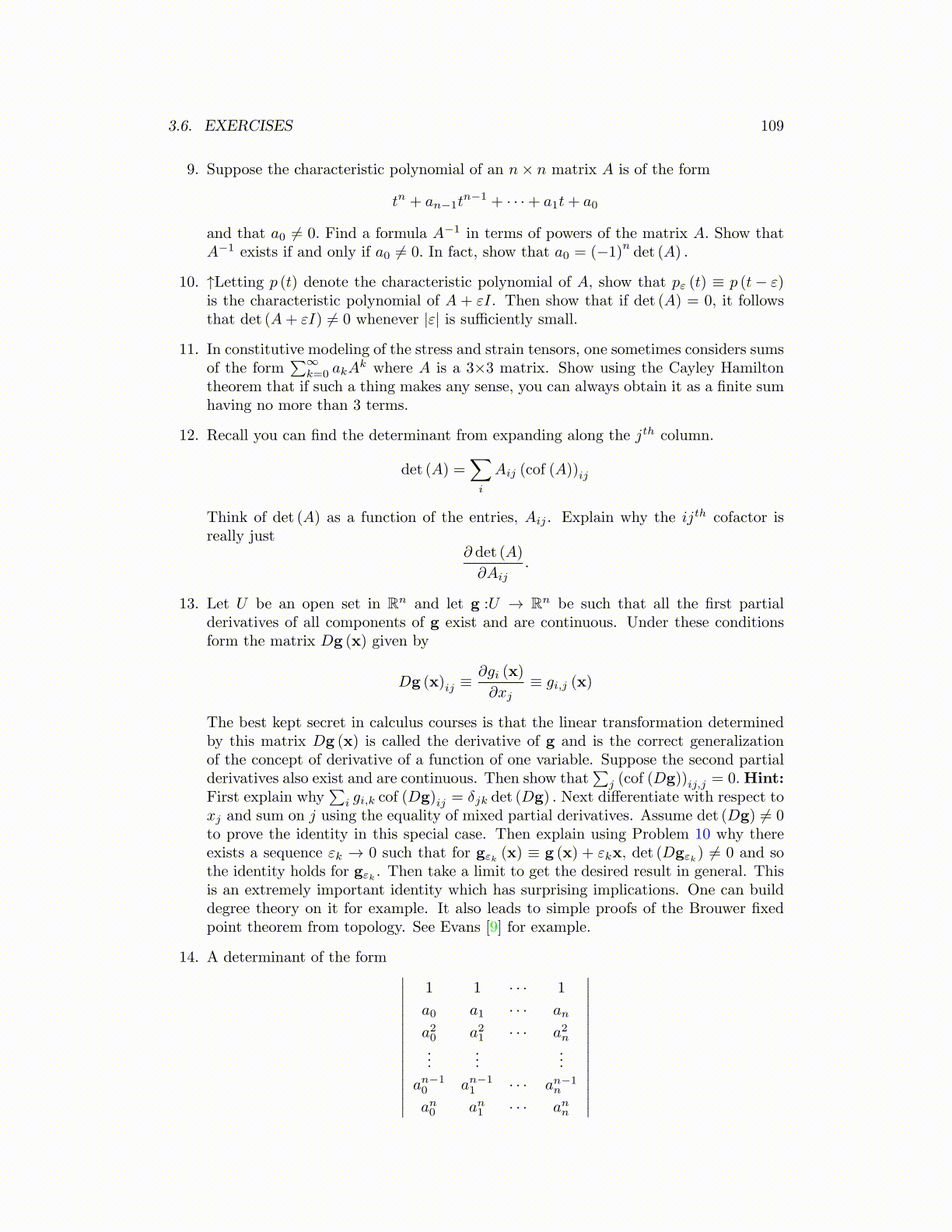
3.6. EXERCISES 109
9. Suppose the characteristic polynomial of an n× n matrix A is of the form
tn + an−1tn−1 + · · ·+ a1t+ a0
and that a0 ̸= 0. Find a formula A−1 in terms of powers of the matrix A. Show thatA−1 exists if and only if a0 ̸= 0. In fact, show that a0 = (−1)
ndet (A) .
10. ↑Letting p (t) denote the characteristic polynomial of A, show that pε (t) ≡ p (t− ε)is the characteristic polynomial of A + εI. Then show that if det (A) = 0, it followsthat det (A+ εI) ̸= 0 whenever |ε| is sufficiently small.
11. In constitutive modeling of the stress and strain tensors, one sometimes considers sumsof the form
∑∞k=0 akA
k where A is a 3×3 matrix. Show using the Cayley Hamiltontheorem that if such a thing makes any sense, you can always obtain it as a finite sumhaving no more than 3 terms.
12. Recall you can find the determinant from expanding along the jth column.
det (A) =∑i
Aij (cof (A))ij
Think of det (A) as a function of the entries, Aij . Explain why the ijth cofactor isreally just
∂ det (A)
∂Aij.
13. Let U be an open set in Rn and let g :U → Rn be such that all the first partialderivatives of all components of g exist and are continuous. Under these conditionsform the matrix Dg (x) given by
Dg (x)ij ≡∂gi (x)
∂xj≡ gi,j (x)
The best kept secret in calculus courses is that the linear transformation determinedby this matrix Dg (x) is called the derivative of g and is the correct generalizationof the concept of derivative of a function of one variable. Suppose the second partialderivatives also exist and are continuous. Then show that
∑j (cof (Dg))ij,j = 0.Hint:
First explain why∑
i gi,k cof (Dg)ij = δjk det (Dg) . Next differentiate with respect toxj and sum on j using the equality of mixed partial derivatives. Assume det (Dg) ̸= 0to prove the identity in this special case. Then explain using Problem 10 why thereexists a sequence εk → 0 such that for gεk (x) ≡ g (x) + εkx, det (Dgεk) ̸= 0 and sothe identity holds for gεk . Then take a limit to get the desired result in general. Thisis an extremely important identity which has surprising implications. One can builddegree theory on it for example. It also leads to simple proofs of the Brouwer fixedpoint theorem from topology. See Evans [9] for example.
14. A determinant of the form ∣∣∣∣∣∣∣∣∣∣∣∣∣∣∣
1 1 · · · 1
a0 a1 · · · an
a20 a21 · · · a2n...
......
an−10 an−1
1 · · · an−1n
an0 an1 · · · ann
∣∣∣∣∣∣∣∣∣∣∣∣∣∣∣